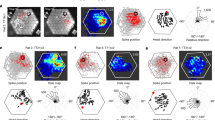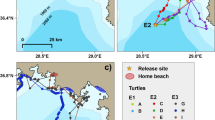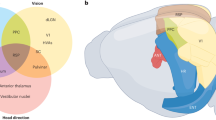Abstract
Animals are capable of true navigation if, after displacement to a location where they have never been, they can determine their position relative to a goal without relying on familiar surroundings, cues that emanate from the destination, or information collected during the outward journey1,2. So far, only a few animals, all vertebrates, have been shown to possess true navigation3. Those few invertebrates that have been carefully studied return to target areas using path integration, landmark recognition, compass orientation and other mechanisms that cannot compensate for displacements into unfamiliar territory4,5. Here we report, however, that the spiny lobster Panulirus argus oriented reliably towards a capture site when displaced 12–37 km to unfamiliar locations, even when deprived of all known orientation cues en route. Little is known about how lobsters and other animals determine position during true navigation. To test the hypothesis that lobsters derive positional information from the Earth's magnetic field, lobsters were exposed to fields replicating those that exist at specific locations in their environment. Lobsters tested in a field north of the capture site oriented themselves southwards, whereas those tested in a field south of the capture site oriented themselves northwards. These results imply that true navigation in spiny lobsters, and perhaps in other animals, is based on a magnetic map sense.
This is a preview of subscription content, access via your institution
Access options
Subscribe to this journal
Receive 51 print issues and online access
$199.00 per year
only $3.90 per issue
Buy this article
- Purchase on Springer Link
- Instant access to full article PDF
Prices may be subject to local taxes which are calculated during checkout



Similar content being viewed by others
References
Griffin, D. R. Bird navigation. Biol. Rev. 27, 359–400 (1952)
Phillips, J. B. Magnetic navigation. J. Theor. Biol. 180, 309–319 (1996)
Phillips, J. B., Adler, K. & Borland, S. C. True navigation by an amphibian. Anim. Behav. 50, 855–858 (1995)
Wehner, R., Michel, B. & Antonsen, P. Visual navigation in insects: Coupling of egocentric and geocentric information. J. Exp. Biol. 199, 129–140 (1996)
Walker, M. M. in Orientation and Communication in Arthropods (ed. Lehrer, M.) 187–213 (Birkhäuser, Basel, 1997)
Kramer, G. Experiments in bird orientation and their interpretation. Ibis 99, 196–227 (1957)
Able, K. P. The concepts and terminology of bird navigation. J. Av. Biol. 32, 174–183 (2001)
Able, K. P. Common themes and variations in animal orientation systems. Amer. Zool. 31, 157–167 (1991)
Walcott, C. Pigeon homing: Observations, experiments, confusions. J. Exp. Biol. 199, 21–27 (1996)
Gould, J. L. The map sense of pigeons. Nature 296, 205–211 (1982)
Wiltschko, R. & Wiltschko, W. Magnetic Orientation in Animals (Springer-Verlag, Berlin, 1995)
Walcott, C. in Orientation in Birds (ed. Berthold, P.) 38–51 (Birkhauser, Boston, 1991)
Papi, F. Animal navigation at the end of the century: A retrospect and a look forward. Ital. J. Zool. 68, 171–180 (2001)
Herrnkind, W. in The Biology and Management of Lobsters (eds Cobb, J. S. & Phillips, B. F.) 349–407 (Academic Press, New York, 1980)
Herrnkind, W., Van Derwalker, J. & Barr, L. Population dynamics, ecology, and behavior of spiny lobster, Panulirus argus, of St. John, U. S. Virgin Islands: Habitation and patterns of movements. Results of the Tektite program, vol. 2. Sci. Bull., Nat. Hist. Mus., Los Angeles Co. 20, 31–45 (1975)
Creaser, E. P. & Travis, D. Evidence of a homing instinct in the Bermuda spiny lobster. Science 112, 169–170 (1950)
Lohmann, K. J. et al. Magnetic orientation of spiny lobsters in the ocean: Experiments with undersea coil systems. J. Exp. Biol 198, 2041–2048 (1995)
Fischer, J. H., Freake, M. J., Borland, S. C. & Phillips, J. B. Evidence for the use of magnetic map information by an amphibian. Anim. Behav. 62, 1–10 (2001)
Lohmann, K. J. & Lohmann, C. M. F. Detection of magnetic field intensity by sea turtles. Nature 380, 59–61 (1996)
Lohmann, K. J. Magnetic remanence in the western Atlantic spiny lobster, Panulirus argus. J. Exp. Biol. 113, 29–41 (1984)
Groeneveld, J. C. & Branch, G. M. Long distance migration of South African deep-water rock lobster, Palinurus gilchristi. Mar. Ecol. Prog. Ser. 232, 225–238 (2002)
Gregory, D. R. & Labisky, R. F. Movements of the spiny lobster, Panulirus argus, in south Florida. Can. J. Fish. Aq. Sci. 43, 2228–2234 (1986)
Gould, J. L. Sensory bases of navigation. Curr. Biol. 8, R731–R737 (1998)
Kirschvink, J. L., Jones, D. S. & MacFadden, B. J. Magnetite Biomineralization and Magnetoreception in Organisms (Plenum, New York, 1985)
Walker, M. M. et al. Structure and function of the vertebrate magnetic sense. Nature 390, 371–377 (1997)
Lohmann, K. J., Cain, S. D., Dodge, S. A. & Lohmann, C. M. F. Regional magnetic fields as navigational markers for sea turtles. Science (Washington DC) 294, 364–366 (2001)
Munro, U., Munro, J. A., Phillips, J. B., Wiltschko, R. & Wiltschko, W. Evidence for a magnetite-based navigational “map” in birds. Naturwissenschaften 84, 26–28 (1997)
Lohmann, K. J. & Lohmann, C. M. F. Detection of magnetic inclination angle by sea turtles: A possible mechanism for determining latitude. J. Exp. Biol 194, 23–32 (1994)
Zar, J. H. Biostatistical Analysis (Prentice Hall, Upper Saddle River, New Jersey, USA, 1996)
Kirschvink, J. Uniform magnetic fields and double wrapped coil systems: Improved techniques for the design of bioelectromagnetic experiments. Bioelectromag. 13, 401–411 (1992)
Acknowledgements
We thank K. Cohen, M. Piet and S. Peters for research assistance, and C. Lohmann and S. Johnsen for a critical reading of manuscript drafts. This work was supported by grants from the PADI Foundation and the National Science Foundation.
Author information
Authors and Affiliations
Corresponding author
Ethics declarations
Competing interests
The authors declare that they have no competing financial interests.
Rights and permissions
About this article
Cite this article
Boles, L., Lohmann, K. True navigation and magnetic maps in spiny lobsters. Nature 421, 60–63 (2003). https://doi.org/10.1038/nature01226
Received:
Accepted:
Issue Date:
DOI: https://doi.org/10.1038/nature01226
This article is cited by
-
Avian navigation: the geomagnetic field provides compass cues but not a bicoordinate “map” plus a brief discussion of the alternative infrasound direction-finding hypothesis
Journal of Comparative Physiology A (2024)
-
Sense of doubt: inaccurate and alternate locations of virtual magnetic displacements may give a distorted view of animal magnetoreception ability
Communications Biology (2023)
-
Human magnetic sense is mediated by a light and magnetic field resonance-dependent mechanism
Scientific Reports (2022)
-
Individualism versus collective movement during travel
Scientific Reports (2022)
-
An artificial neural network explains how bats might use vision for navigation
Communications Biology (2022)
Comments
By submitting a comment you agree to abide by our Terms and Community Guidelines. If you find something abusive or that does not comply with our terms or guidelines please flag it as inappropriate.



